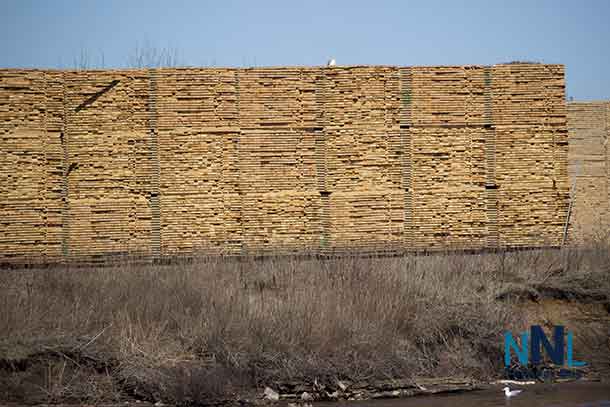THUNDER BAY – The demand for softwood lumber in the United States has remained steady. That demand has provided needed stability to the Northwestern Ontario forest sector of the economy. In North America, British Columbia was the only region which saw a drop in lumber production.
This market has provided the needed stability that in Northwestern Ontario is seeing sawmills re-open.
Resolute Forest Products Inc. (NYSE: RFP) (TSX: RFP) reported net income for the quarter ended September 30, 2017, of $24 million, or $0.26 per share, compared to net income of $14 million, or $0.15 per share, in the same period in 2016. Sales were $885 million in the quarter, essentially unchanged from the third quarter of 2016. Excluding special items, the company reported net income of $31 million, or $0.34 per share, compared to net income, excluding special items, of $15 million, or $0.17 per share, in the third quarter of 2016.
“This quarter’s solid performance builds on the momentum established earlier in the year,” said Richard Garneau, president, and chief executive officer. “Our results benefitted from continued strength in our market pulp and wood products segments as well as from substantial improvements in the cost position of our paper segments following capacity closures and restructuring of operations announced earlier this year. In tissue, our sales effort continues to progress, but our results were negatively impacted by Hurricane Irma.”\
The wood products segment for Resolute recorded operating income of $64 million for the quarter, an improvement of $19 million compared to the previous quarter. With supply disruptions owing mostly to forest fires in British Columbia, shipments increased by 22 million board feet, reaching 531 million board feet for the quarter. The average transaction price rose by $27 per thousand board feet to $413. The delivered cost improved by $8 per thousand board feet, mostly a result of higher volumes. EBITDA for the segment was $73 million, a $21 million increase from the previous quarter, and equivalent to $137 per thousand board feet, compared to $102 in the second quarter. Finished goods inventory declined by 3 million board feet to 122 million board feet.
Global Lumber Trade
Demand for imported softwood lumber to the US has fallen by six percent during the first nine months of 2017 as compared to the same period in 2016. In contrast, Chinese import volumes have been up 21% year-over-year.
The lumber trade in Europe has also picked up in 2017 with the United Kingdom, the Netherlands, Austria, Denmark and Spain have increased imports the most so far in 2017. Countries in the Middle East and North Africa, also known as the MENA countries, have sharply reduced consumption of lumber this year, reports the Wood Resource Quarterly (WRQ). In the first eight months of 2017, Egypt and Algeria (the two biggest lumber consumers in the region) have decreased their imports by 24% and 39% respectively as compared to the first eight months of 2016.
Lumber markets – North America
Lumber consumption in the US did not change much during the first eight months of this year as compared to the same period in 2016, according to the Western Wood Products Association. However, there was an increase in demand during the third quarter, which was met by higher domestic production both in the South and the West. US lumber production has gone up by 3.2% year-over-year, and the only region of North America that saw a reduction in lumber production this year was British Columbia. In August when the forest fires were at their peak, production was 8.7% lower than in August last year.
Increased lumber demand in the Western US and Asia pushed Douglas-fir lumber prices to record highs in the 3Q/17. In the US South, prices for pine lumber were stable during the summer but picked up in the fall after the two hurricanes impacted both the log flow and lumber demand.
Lumber markets – Northern Europe
Shipments of lumber from the Nordic countries slowed in the 3Q/17, with export volumes for Finland and Sweden being down 13% and 18% respectively from the previous quarter. The biggest change in destinations for exported lumber for both countries over the past two years has been the expansion in sales to Asia. In 2017, 20% of the export lumber volume from the Nordic countries was shipped to China and Japan. Lumber prices in both Finland and Sweden strengthened in 2017, and in August, reached their highest levels since early 2015.
Lumber markets – China
Chinese softwood lumber importation is likely to reach a new record high in 2017. During the first nine months, imports were 21% higher than in the same period in 2016, with volumes in the second and third quarter being the highest quarterly imports on record. Russia has been increasing its share of the Chinese lumber market, accounting for 57% of total imports in the 3Q, up from 52% in 2015, according to the WRQ. Average import prices to China have continued their three-year climb this fall and were 19% higher in September than in early 2016 when they were at an eight-year low.
Lumber market – Japan
The lumber market in Japan has been very stable in 2017. In fact, import volumes have consistently ranged between 1.5 and 1.6 million m3 per quarter over the past few years. There have been small shifts in supply sources, with a slight decline in Canadian lumber supply and an increase in shipments from Finland. Prices for domestic and imported lumber to Japan have remained unchanged throughout 2017 in Yen terms except for prices for imported Douglas-fir, which have gone up six percent from January to November.
Lumber market – Russia
The Russian sawmilling sector continues to add capacity in Siberia and the Far East, targeting the expanding demand for lumber in China. Just during the first eight months of this year, Russia increased shipments to China by 23% as compared to the same period in 2016. Although Russian lumber prices have not changed much in Ruble terms over the past two years, there has been a steady increase in export prices as measured in US dollars.




